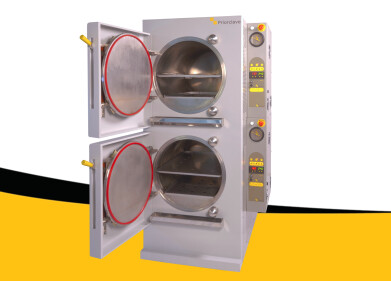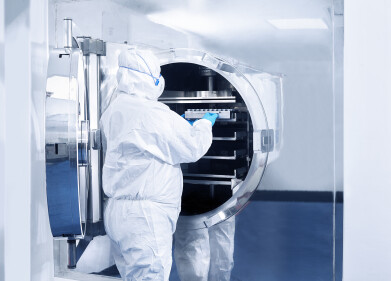-
 Figure 1: Unistats facilitate extremely efficient tempering of externally connected applications such as reactors which saves time and costs.
Figure 1: Unistats facilitate extremely efficient tempering of externally connected applications such as reactors which saves time and costs. -
 Figure 2: During connection, make sure that suitable hoses are used and that they are not squeezed.
Figure 2: During connection, make sure that suitable hoses are used and that they are not squeezed. -
 Figure 3: The selection of the right circulation pump is decisive for good heat transfer. In most applications the delivery rate is more important than the pressure.
Figure 3: The selection of the right circulation pump is decisive for good heat transfer. In most applications the delivery rate is more important than the pressure. -
 Figure 4: Adjusting an exothermic reaction in a reactor is fast and reliable - that permanently protects expensive temperature control products.
Figure 4: Adjusting an exothermic reaction in a reactor is fast and reliable - that permanently protects expensive temperature control products. -
 Figure 5: The 'Petite Fleur' is one of the smallest Unistats and is perfect for research laboratories.
Figure 5: The 'Petite Fleur' is one of the smallest Unistats and is perfect for research laboratories. -
 Figure 6: In case studies with various reactor systems, the small Petite Fleur repeatedly demonstrates its productive efficiency.
Figure 6: In case studies with various reactor systems, the small Petite Fleur repeatedly demonstrates its productive efficiency. -
 Figure 7: The Unistat series covers more than 60 standard models with cooling capacities of up to 150 kW. In research laboratories the three smallest models are most popular: the Petite Fleur, Grande Fleur and the Tango.
Figure 7: The Unistat series covers more than 60 standard models with cooling capacities of up to 150 kW. In research laboratories the three smallest models are most popular: the Petite Fleur, Grande Fleur and the Tango.
Temperature Control / Sterilising
Power is not the same as efficiency What needs to be considered when comparing cooling heating or circulators
Feb 19 2018
Many research tasks in the laboratory require exact temperature control. However, choosing the right circulator is not always straightforward. Advertising claims such as 'extremely fast' or 'high cooling capacity' are not very meaningful and do not permit any objective assessment. Also difficult: the comparison of manufacturer information since the measurement methods used to determine it often differ.
It is essential for the user to be able to make meaningful comparisons. DIN 12876 defines various characteristics and measurement methods for this purpose. These should be used as an orientation for heating circulators and cryostats. Characteristics recorded in this manner facilitate a reliable comparison of the performance.
Different concepts
There are two types of temperature control devices on the market. Along with open bath circulators, closed temperature control systems are also available, sometimes referred to as process control circulators. The latter device class originated more than 25 years ago with the 'Unistat Tango'. The Unistat Tango concept, which was completely new back then, created a huge technological advance in temperature control. In contrast to conventional bath circulators, for the very first time the 'Unistat Tango' worked with a closed temperature control circuit. Unistats are circulators thermostats without an internal bath. An expansion tank replaces the conventional bath to accommodate thermal expansion and this is where the volume change takes place. The mass to be thermoregulated is reduced which in turn increases the speed of temperature change. These properties make Unistats predestined for temperature control tasks in process technology and process engineering such as in reactors, autoclaves, miniplant/pilot plants, reaction blocks and calorimeters.
Thermodynamics – how fast is a system?
When considering the question of the dynamics of a temperature control device, the heating or cooling capacity (kW) is normally used as a comparative value. The power generated in the thermostats however is not sufficient for making a meaningful assessment. The system mass which has to be thermoregulated must be considered. That is why to make a meaningful comparison the cooling power density (watts/litres) as per DIN 12876 is most suitable. Always applicable: the greater the cooling power density, the more dynamic (faster) the thermostat can react to a temperature-change requirement.
Example:
Consider two temperature control devices from different suppliers. The cooling capacity of both devices is the same; likewise the pump flowrate (l/min) and both temperature control devices are connected to identical applications (e.g. glass reactors). To be able to make a statement on the dynamics (cool-down/heat up time), we can use the following formula:
P = m * c *dT/dt
(P = Power; m = Total mass; c = Spec. heating capacity; dT = Temperature difference; dt = time)
Rearranged for the cooling time dt: dt = m * c * dT/P
The expression c * dT/P is the same for both applications. However, it’s worth taking a closer look at the mass.
Temperature-control device 1 has a mass of 5 kilograms (fill volume, not the inherent weight of the device). Temperature-control device 2 has a mass of 10 kg. The mass of the external applications amounts to 5 kg. The first case results in a total mass of 10 kg (internal filling volume plus the external application); in the second case 15 kg have to be cooled (or heated). The ratio is 2:3, or in other words: Temperature control device 1 is only needed 2/3 of the time. That means the time saving is 33%.
The example demonstrates that the cooling capacity is certainly an important factor. However, this should also be applied to the temperature control fluid volume being used. The result is the cooling capacity density and this can be used to make a meaningful comparison (see DIN). By the way: Temperature-control device 1 also saves 1/3 of the temperature-control fluid and the energy!
Pressure or flowrate?
The flow rate of the circulation pump is another important criterion. It has a strong influence on the heat transfer between a circulator and the temperature control fluid. According to DIN, the cooling capacity should be measured at full pump output. When the pump output is reduced, the heat transfer is lower. This leads to more net cooling capacity and facilitates lower temperatures. Important for most applications is not the pressure output (bar) but the highest possible flowrate (l/min). The point is ultimately not how much power a thermostat generates; rather it is the efficiency of the heat transfer to or from the process. Output is useless if it is not efficiently transferred to the application.
Circulation pumps are ideally designed so that a turbulent flow generates a large heat transfer coefficients (alpha value) and thus efficient heat transfer to/from the internal heat exchangers (evaporator and heating). In practice, in 90% of all applications glass is used (reactors, distillation apparatus, etc.) and the permissible system pressure in these applications is maximum 0.5 bar. This is why Unistat pumps offer large circulation volumes instead of high pressure, they need significantly less (pumping) motor output to accomplish high flowrates.
Summary
When selecting a circulator there are several points that need to be considered. Ultimately, it is not only the heating and cooling capacities stated in the manufacturer’s catalogue that are relevant - rather criteria such as the cooling density, flowrate and if available case studies should be paramount since that is the only way to be able to make a realistic assessment of the heat transfer efficiency.
Digital Edition
Lab Asia 31.6 Dec 2024
December 2024
Chromatography Articles - Sustainable chromatography: Embracing software for greener methods Mass Spectrometry & Spectroscopy Articles - Solving industry challenges for phosphorus containi...
View all digital editions
Events
Jan 22 2025 Tokyo, Japan
Jan 22 2025 Birmingham, UK
Jan 25 2025 San Diego, CA, USA
Jan 27 2025 Dubai, UAE
Jan 29 2025 Tokyo, Japan


















